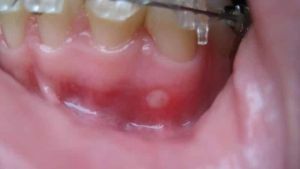 Stomatitis is a disease of the oral mucosa, which causes foci of inflammation and damage in the mouth.
Stomatitis is a disease of the oral mucosa, which causes foci of inflammation and damage in the mouth.
Stomatitis has several varieties, so inflammation and ulcers are often localized in the sky and gums - in most cases, this pathology does not endanger the body of both adults and children, but causes discomfort and pain.
Contents
- Prophylaxis
- Clinical picture
- Diagnostic criteria
- Treatment methods
- Preventative measures
Provoking factors
There are several theories explaining why stomatitis develops. High support among specialists has an opinion according to which the disease appears against the background of a decrease in the body's immune defense.
The following people are at high risk:
- children during their first years of life;
- are pregnant;
- of the elderly;
- patients with diseases depressing immunity( HIV infection, tumors);
- persons who have been taking antibiotics for a long time and a number of other medications.
In the oral cavity there are always various pathogenic microorganisms, the development of which is suppressed by the work of the immune system. Against the background of the weakening of the latter, the bacteria begin to multiply actively, provoking the appearance of foci of inflammation in the gum tissue or in the sky.
Stomatitis in both adults and children often develops under the influence of the following factors: 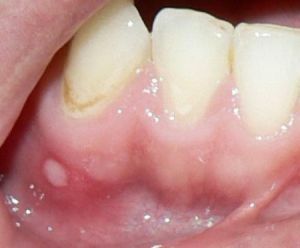
- frequent trauma to the palate and gums;
- regular intake of acute and sour food, as well as the use of toothpastes with lauryl sodium sulfate( they irritate the surface of the mucosa);
- strong emotional overstrain;
- is an allergic reaction to food and substances that are contained in cleaning and mouthwash products;
- unbalanced food, which contains no trace elements necessary for the organism;
- hormonal imbalance;
- diseases of the gastrointestinal tract.
In a child, stomatitis, and with it inflammation of the mucous membranes of the palate, the inner surface of the cheeks, and bleeding gums on the gums, often develops for two reasons:
- weakened immunity;
- inadequate oral hygiene.
Children are more susceptible to various pathogenic factors. Their immunity in the first few years is only being formed.
Clinical picture of
The main sign that indicates the course of the inflammatory process in stomatitis is the characteristic manifestations in the sky or gums, which often bleed.
The formation of such neoplasms is accompanied by pain syndrome.
At the initial stage, a red dot appears on the site of future erosion, indicating an inflammatory process. Later, an ulcer with clear boundaries is formed here, having a round or oval shape. Over time, a white patch and spots appear on its surface. In this case, the mucous membrane, located next to the ulcer, retains its original appearance.
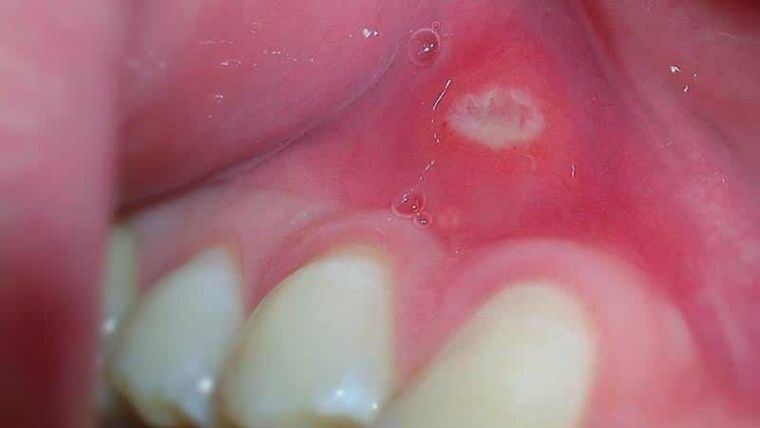
In the photo, the characteristic symptomatology for stomatitis is an ulcer and inflammation on the gums. ..
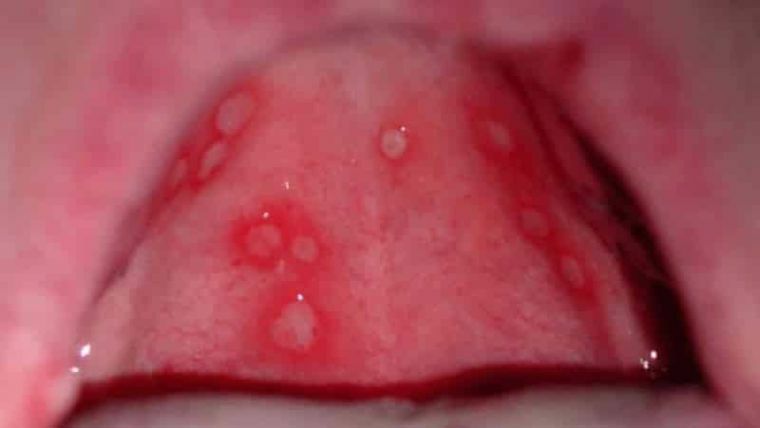
. .. and the sky
With stomatitis, the appearances appearing on the gum and the sky can be single and multiple. In severe cases, neoplasms coalesce with each other, forming large spots.
Regardless of the age of the patient, the course of the pathology is accompanied by the appearance of the following symptoms:
- elevated temperature reaching 38 degrees;
- enlarged lymph nodes, when pressed, pain occurs;
- increased fatigue and irritability;
- frequent headaches;
- gums and palate bleed;
- decreased appetite;
- active salivation;
- unpleasant odor coming from the mouth.
Separate attention deserves the aphthous type of the disease. The development of this form is accompanied by a similar clinical picture, except for the formation of aphthae on the gum and the sky. The latter also represent ulcers, the sizes of which reach 3-5 mm.
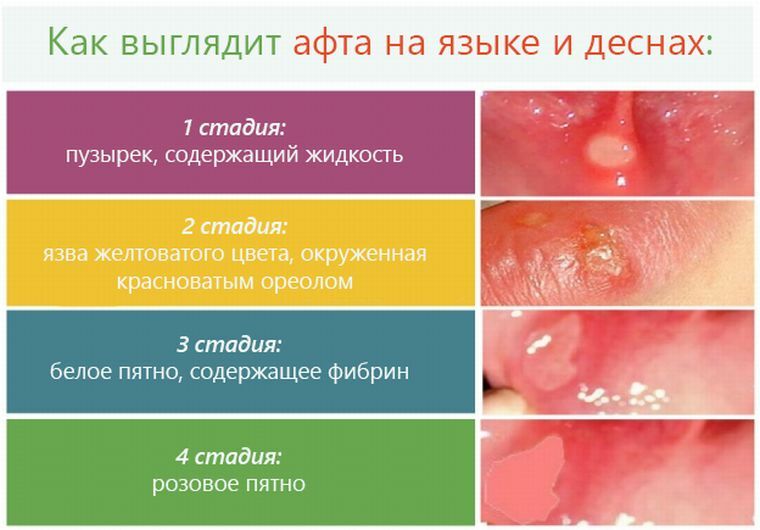
In children, the disease manifests itself in a similar way. To diagnose the presence of pathology in children in the first year of life can be due to frequent crying and unreasonable anxiety.
In medical practice, depending on the severity of the disease, it is common to distinguish three forms of stomatitis: 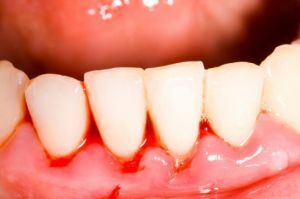
- Easy .With this form of the disease, there are painful sensations, swelling and hemorrhage of the mucous membrane in the affected area.
- Average .The development of pathology causes a change in the shape of the gingival margin. With moderate stomatitis in the oral cavity, the presence of necrotic( dead) tissue can be detected. In addition, heat and suppuration in the affected area are diagnosed.
- Heavy .This form of pathology is characterized by a vast area of damage, in which the sky and cheeks are involved. In rare cases, bone tissue develops.
Often the course of the disease is accompanied by the development of infectious pathologies. Long-term development of dental disease causes intoxication of the body. In children, the inflammatory process in the mucosa often occurs against the background of other diseases.
Diagnostic criteria
If suspected of stomatitis, the diagnosis is made on the basis of an oral examination by the dentist. Also, the doctor needs to find out the true cause of the disease. For this purpose, information is collected on the patient's condition, the presence of concomitant diseases.
In addition, the following are prescribed:
- blood test;
- collection of material for subsequent microscopic and histological examination and other procedures.
The absence of the need for specialized diagnostic methods is explained by the fact that the pathology has characteristic features manifested as ulcers on the mucous membrane.
Methods of therapy
Often, the symptoms of stomatitis disappear without external intervention. The influence of pathogenic microflora suppresses the human immune system. In other cases, antiseptic treatment of the affected area is prescribed, which allows eliminating the symptoms of the disease and suppressing the course of the inflammatory process.
 At the initial stage of treatment, irrigation of the oral cavity with special solutions is recommended to be performed every three hours. This approach will prevent the emergence of complications. If the disease has an easy form of flow, then the positive results become noticeable on the third day after the start of treatment.
At the initial stage of treatment, irrigation of the oral cavity with special solutions is recommended to be performed every three hours. This approach will prevent the emergence of complications. If the disease has an easy form of flow, then the positive results become noticeable on the third day after the start of treatment.
With an infectious basis, antiviral drugs and ointments are prescribed. Vitamin complexes are also recommended for strengthening immune defense.
In severe cases, stomatitis requires surgical treatment - treatment of ulcers on the gums, the sky and other mucous membranes. In addition, the doctor can prescribe antibiotics, which are administered intramuscularly.
To remove the characteristic coating, hydrogen peroxide is used. This drug simultaneously carries out antibacterial treatment of the expressed mucous membrane. To accelerate the process of regeneration of damaged tissue keratoplasty is recommended.
During the treatment, it is necessary to adjust the daily diet. From it, for the first time, it is necessary to exclude solid products, when chewing gums undergo heavy loads. It is recommended to give preference to puree food. Do not consume too cold and hot foods.
Treatment of stomatitis in children is carried out according to a similar scheme. Exceptions are cases requiring the use of antibiotics. In such circumstances, it is highly discouraged to give such medications to a child without consulting a doctor. In the treatment of the disease in children  are used:
are used:
- painkillers( Dentinox, Calgel, Kamistad);
- antiseptics( Miramistin, solution of chamomile or calendula, Chlorhexidine);
- antipyretics.
When a characteristic ulcer on the gum and( or) the sky in a child, it must be isolated from other children. To the sick kid it is necessary to allocate separate tablewares.
These recommendations are due to the fact that the infection that triggered the development of stomatitis can be transferred to the patient's environment.
Preventive measures
Preventing the development of the disease allows the following activities:
- regular oral examination;
- application of high-quality toothpastes;
- constant adherence to hygiene rules;
- strengthening of the immune system;
- timely treatment of dental and other diseases.
Stomatitis in the severe stage provokes necrotic soft tissue, which leads to the formation of osteomyelitis. The long course of the disease contributes to the development of periodontitis, which results in loss of teeth.
